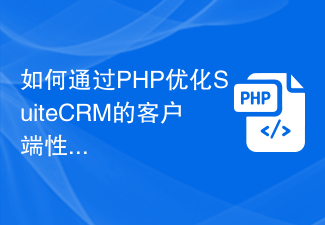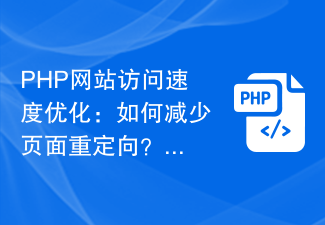 Backend Development
Backend Development PHP Tutorial
PHP Tutorial Optimization of PHP operating environment and solutions to common problems
Optimization of PHP operating environment and solutions to common problemsIn order to improve the performance and access speed of the website, it is very important to optimize the PHP running environment. Solutions to some common problems also need to be mastered in practical applications.
1. Optimization of PHP running environment
1. Select the appropriate PHP version and library files
Different versions of PHP and library files will produce obvious performance differences. For modern web applications, PHP 7 is a good choice because it is much faster than previous versions. At the same time, using cache extensions such as OPcache or APC can improve performance.
2. Turn on OPcache caching
OPcache is a PHP extension that can cache the intermediate code of PHP scripts, thereby improving PHP execution speed. Turning on OPcache caching can greatly reduce the execution time of each request, thereby improving the server's throughput.
3. Turn off the Xdebug debugger
Xdebug is a very powerful debugger, but it can have a huge impact on performance. Therefore, Xdebug should be turned off in the production environment to improve PHP execution speed.
4. Enable persistent connections
Using persistent connections in the database connection pool can greatly reduce the cost of establishing a connection for each request. Although persistent connections can easily lead to overloading the number of database connections, they can significantly improve performance under reasonable use.
2. Solutions to common problems
- The front-end page loads slowly
In the front-end page, some resource files (such as JS, CSS, images, etc.) ) loads too slowly, which will affect the loading speed of the page. You can optimize the front-end page loading speed in the following ways:
- Compress CSS, JS and other resource files to reduce file size during transmission
- Use CDN to accelerate, away from users Obtain resources from closer network nodes
- The images use lazy loading technology, so that the image resources are loaded asynchronously after the page is loaded
- Avoid excessive HTTP requests and reduce the number of resource files
- Excessive database connections lead to performance problems
In high concurrency situations, operations such as creation, release, and query of database connections will cause large CPU and memory overhead. To deal with database problems, you can start from the following aspects:
- Connection pool technology, reuse existing connections to reduce overhead
- Use indexes, reduce query time
- Cache results to avoid frequent queries
- Separate reading and writing of the database to reduce pressure on the main library
- Excessive memory consumption
In some request processing During the process, the program will use a large amount of memory, causing memory shortage, system instability or even hang. The optimization is as follows:
- Optimize the HTML structure of the page
- Reduce the number of HTTP requests as much as possible
- Enable the PHP memory recycling mechanism
- Reduce the number of cycles
- SQL injection problem
SQL injection is a very common web attack method. Attackers construct special SQL statements to bypass verification and steal data. the goal of. The following measures can be used to prevent SQL injection attacks:
- Use precompiled statements to avoid SQL injection attacks
- Filter user input and perform parameterized queries to reduce the risk of SQL injection
- Encrypt key data and improve data security
Summary
As a widely used programming language, PHP has a lot of room for optimization, and it can also deal with common problems. Corresponding solutions are needed. Mastering the optimization methods of PHP running environment and solutions to common problems can better improve the performance and security of web applications.
The above is the detailed content of Optimization of PHP operating environment and solutions to common problems. For more information, please follow other related articles on the PHP Chinese website!
 如何使用APCu缓存技术优化PHP应用程序的性能?Jun 20, 2023 pm 09:47 PM
如何使用APCu缓存技术优化PHP应用程序的性能?Jun 20, 2023 pm 09:47 PM目前,PHP已成为互联网开发中最加盛行的编程语言之一,而PHP程序的性能优化也成为了最紧迫的问题之一。在处理大规模的并发请求时,一秒钟的延迟都可能对用户体验产生巨大的影响。如今,APCu(AlternativePHPCache)缓存技术已经成为优化PHP应用性能的一种重要的方法之一。本文将介绍如何使用APCu缓存技术来优化PHP应用程序的性能。一、APC
 如何使用Memcached缓存技术优化PHP应用程序CPU的使用率?Jun 21, 2023 pm 05:07 PM
如何使用Memcached缓存技术优化PHP应用程序CPU的使用率?Jun 21, 2023 pm 05:07 PM随着互联网的发展,PHP应用程序在互联网应用领域中变得越来越常见。但是,PHP应用程序的高并发访问会导致服务器的CPU使用率高,从而影响应用程序的性能。为了优化PHP应用程序的性能,Memcached缓存技术成为了一种很好的选择。本文将介绍如何使用Memcached缓存技术优化PHP应用程序CPU的使用率。Memcached缓存技术简介Memcached是一
 如何通过PHP优化SuiteCRM的客户端性能Jul 20, 2023 am 10:00 AM
如何通过PHP优化SuiteCRM的客户端性能Jul 20, 2023 am 10:00 AM如何通过PHP优化SuiteCRM的客户端性能概述:SuiteCRM是一个功能强大的开源客户关系管理(CRM)系统,但在处理大量数据和并发用户时,可能会出现性能问题。本文将介绍一些通过PHP编程技巧来优化SuiteCRM客户端性能的方法,并附上相应的代码示例。使用适当的数据查询和索引数据库查询是CRM系统的核心操作之一。为了提高查询性能,需要使用适当的数据查
 如何优化PHP的数据库连接和查询性能?Jun 29, 2023 am 10:25 AM
如何优化PHP的数据库连接和查询性能?Jun 29, 2023 am 10:25 AM如何优化PHP的数据库连接和查询性能?数据库是Web开发中不可或缺的一部分,而PHP作为一种广泛使用的服务器端脚本语言,其与数据库的连接和查询性能对于整个系统的性能至关重要。本文将介绍一些优化PHP数据库连接和查询性能的技巧和建议。使用持久化连接:在PHP中,每次执行数据库查询时都会建立一次数据库连接。而持久化连接可以在多次查询中重用同一个数据库连接,从而减
 如何利用PHP优化SuiteCRM的项目管理功能Jul 17, 2023 am 11:34 AM
如何利用PHP优化SuiteCRM的项目管理功能Jul 17, 2023 am 11:34 AM如何利用PHP优化SuiteCRM的项目管理功能SuiteCRM是一款功能强大的开源客户关系管理(CRM)系统,它提供了广泛的功能和可定制性。在项目管理方面,SuiteCRM提供了一些基本功能,如任务分配、进度跟踪和文件共享等。然而,有时我们需要根据特定的业务需求对项目管理功能进行优化。在本文中,我们将介绍如何利用PHP编程语言来扩展和优化SuiteCRM的
 如何利用PHP优化织梦建站效果Mar 27, 2024 pm 01:51 PM
如何利用PHP优化织梦建站效果Mar 27, 2024 pm 01:51 PM如何利用PHP优化织梦建站效果在当今互联网崛起浪潮中,搭建一个高效、优质的网站愈发重要。织梦(DedeCMS)是一个功能强大的建站系统,但有时候它的默认功能可能无法完全满足我们的需求。在这篇文章中,我们将探讨如何利用PHP优化织梦建站效果,并提供一些具体的代码示例。1.优化网站速度网站速度是用户体验和SEO排名的重要因素之一,通过优化PHP代码可以提高网站
 PHP网站访问速度优化:如何减少页面重定向?Aug 08, 2023 pm 02:34 PM
PHP网站访问速度优化:如何减少页面重定向?Aug 08, 2023 pm 02:34 PMPHP网站访问速度优化:如何减少页面重定向?概述:在开发和优化一个PHP网站时,提高网站的访问速度是一个关键的考虑因素。页面重定向是一个常见的性能问题,它会导致额外的HTTP请求和延迟,从而影响用户体验。本文将介绍如何通过减少页面重定向来优化PHP网站的访问速度,并提供一些代码示例。检查并修复无效的URL跳转:页面重定向通常是由于无效的URL跳转所引起的。这
 如何优化PHP常见问题合集的开发流程Sep 12, 2023 pm 01:03 PM
如何优化PHP常见问题合集的开发流程Sep 12, 2023 pm 01:03 PM如何优化PHP常见问题合集的开发流程导言:PHP常见问题合集是一个常用的开发工具,旨在解决PHP开发过程中常见的问题或者提供一些实用的功能。然而,在开发这样一个工具的过程中,可能会遇到一些开发效率低下、代码质量低下等问题。本文将介绍如何优化PHP常见问题合集的开发流程,以提高开发效率和代码质量。一、制定明确的开发计划在开发PHP常见问题合集之前,需要制定一个


Hot AI Tools

Undresser.AI Undress
AI-powered app for creating realistic nude photos

AI Clothes Remover
Online AI tool for removing clothes from photos.

Undress AI Tool
Undress images for free

Clothoff.io
AI clothes remover

AI Hentai Generator
Generate AI Hentai for free.

Hot Article

Hot Tools

SublimeText3 English version
Recommended: Win version, supports code prompts!

SAP NetWeaver Server Adapter for Eclipse
Integrate Eclipse with SAP NetWeaver application server.

WebStorm Mac version
Useful JavaScript development tools

SublimeText3 Linux new version
SublimeText3 Linux latest version

MinGW - Minimalist GNU for Windows
This project is in the process of being migrated to osdn.net/projects/mingw, you can continue to follow us there. MinGW: A native Windows port of the GNU Compiler Collection (GCC), freely distributable import libraries and header files for building native Windows applications; includes extensions to the MSVC runtime to support C99 functionality. All MinGW software can run on 64-bit Windows platforms.





